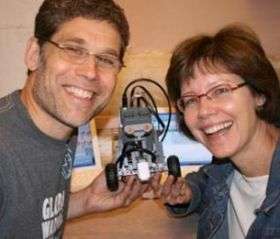Not exactly your grandfather's Lego

(PhysOrg.com) -- Some students just can't get enough of a good thing. Willingly spending more than 11 hours a day in a classroom is what happens when you combine Lego robotics with inquisitive minds.
Fourteen teachers were on the University of Alberta campus last week building and programming their own robots as part of educational psychology's Robotics and Learning: Constructionism in Practice, a unique course offered to educators by the Faculty of Education.
Teachers John Lobe and Jill Usher from Elk Island Public Schools, along with other student educators in the class, built and programmed Starbuck, a little robot whose job includes responding to automated commands of its creators and conquering various challenges.
"After we built Starbuck we put him through a number of tasks, one of which included instructing the robot to find the edge of a table, back up and continue to explore the table without falling off," said Usher.
Lobe added Starbuck's own problem-solving skills are enriched with each challenge.
"It's one thing to have an abstract idea, quite another to make it come to life," said Lobe. "When our tribot meets each challenge, we push it further and make more program adaptations to challenge it even more."
And this is precisely the hope of course creator and professor in educational psychology, Mike Carbonaro, who first started teaching robotics to education students in 2001.
"This is the first time we've offered a course in Lego robotics just for teachers," said Carbonaro, a strong advocate of inquiry-based learning where real-world critical thinking can take place. "I've had students who stay for 12 hours a day and never want to go home. You don't see this too often."
Jeff Warner, Carbonaro's co-instructor and a graduate student in educational psychology, first took the course from Carbonaro while an undergraduate and says he can't get enough of this style of learning.
"The Lego robotics sets are the greatest thing ever," said Warner. "As a math and science major, it occurred to me that the robot was a tool I could use in my classroom. Students are so excited and inspired; they don't even realize that they are learning math and science principles while programming and building their robot."
Warner now works for the Faculty of Education in the technology professional development unit, and is also the first student enrolled in the educational technology master's program. "Lego robotics is growing exponentially in popularity and interest," he said. "I am excited to continue to look at ways to expose the technology as an effective tool for teaching and learning."
For Carbonaro, learning about technology in a non-threatening and productive way can often be achieved when the students are creating projects they enjoy doing.
"Building your own robot and programming it to carry out a task can teach students various aspects of logical problem solving, while simultaneously requiring them to consider multiple solution pathways."
Carbonaro adds the process encourages students to reflect on their thinking processes and challenges them to implement pragmatic solutions. "Further, the concept of a 'robot' itself conjures up social and emotional images that beg questions such as, 'What impact will robotics technology have in the working world? or 'Is it ethical to replace humans with robots?'"
The project is partially supported by an in-kind equipment contribution from Spectrum Educational Supplies.
Educational Psychology at the University of Alberta:
www.uofaweb.ualberta.ca/edpsychology/
Provided by University of Alberta





















